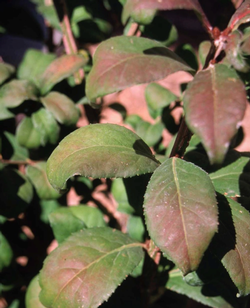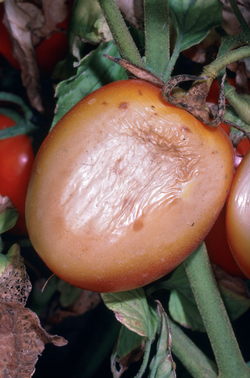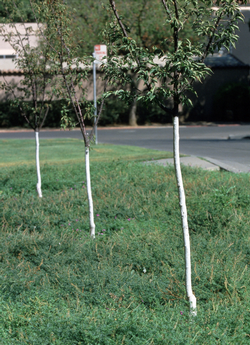Ouch! Plants sunburn, too!
-
Dot Zanotti Ingels
-
We all know about sunburn on our skin, and unfortunately, our trees and plants are susceptible, too. Sometimes when plants look sick or are under attack by insects they actually may be signaling stress from environmental issues.
 These leaves show an example of sun damage. Photo: Courtesy of UCNR Repository
These leaves show an example of sun damage. Photo: Courtesy of UCNR RepositoryPlant sunburn, sunscald, or scorch is the damage to bark, foliage, fruit, and other aboveground plant parts that is caused by excessive exposure to solar radiation. The scorch most often happens following prolonged periods of dry, windy weather, or bright sunshine when the roots cannot supply enough hydration to overcome the excessive solar exposure. Sunburn injury is usually most severe on the south or southwest sides of trunks, branches, or on plants where the sunlight is most intense.
What does sunburn look like?
Sunburned foliage can appear in many ways:
- abnormally shiny
- wilting
- washed out or bleached pigments
- blotchy burns in shades of white, yellow or brown
- wrinkled, crispy leaves
In mild cases of leaf scorch, the leaves may stay attached with little resulting damage. If the exposure is more severe, the leaves may fall off, but the plant will probably not die, and it will make new leaves. Where leaf scorch occurs each year, the annual stress will gradually weaken the plant, leaving it more susceptible to insects and disease. Here is an example of sunscald on a tomato. Photo: UC Regents
Here is an example of sunscald on a tomato. Photo: UC RegentsSunburn also occurs on the stems or trunks of young woody plants. Their bark is still thin and their canopy may still not be large enough to shade it. Older trees can also be damaged if their environment changes by heavy pruning, losing a shade structure, or by increasing the reflective surface around them when adding pavement. Sunburned bark initially appears discolored and then becomes dry and sunken. Soon the injured bark will crack and peel making it susceptible to attack by wood-boring insects or wood decay.
Here are some ways to avoid sunscald:
- Choose plants that are adapted to the planting site. Do not try to grow shade-loving plants in full sun. Employ the UC Marin Master Gardener mantra of “right plant, right place”.
- Water when needed to maintain plant vigor. For shrubs, annuals and some perennials this means the soil should be moist to a depth of 10-12 inches after a thorough watering. Check soil moisture frequently, especially during times of intense heat and wind. Also, research the hydration requirements for your trees.
- Prune judiciously. For young trees, retain temporary lower branches or any leaves that are growing along the trunk that help shade the trunk. For all trees, avoid pruning in summer and avoid pruning off more than about 20% of the plant’s canopy during any one year.
 Whitewashing trunks of young trees with interior water-based latex paint can help prevent sunburn. Photo: Jack Kelly Clark, UC IPM Program
Whitewashing trunks of young trees with interior water-based latex paint can help prevent sunburn. Photo: Jack Kelly Clark, UC IPM Program - Organic mulches can conserve soil moisture and reduce soil temperatures during the summer. This is especially important in drought years.
- Protect your plants with shading or screening, if needed, especially in times of intense sun and heat. You can do this with a shade structure, modifying the site to provide partial shade, or even use a simple umbrella.
- Whitewashing trunks helps to prevent sunburn. Use white interior latex water-based paint diluted with an equal volume of water applied to the trunks of young trees and to older bark newly exposed to the sun if it is susceptible to sunburn. Exterior water-based or oil paints are not safe to use on trees.
- There are light-colored tree wraps available that can help.
This is a tough year for our gardens as we try to conserve our precious water resources. Adapting our plantings will help us keep what we have growing as healthy as possible.



